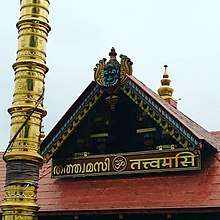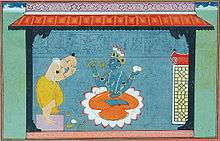Tat Tvam Asi
Tat Tvam Asi (Devanagari: तत्त्वमसि, Vedic: tát túvam ási), a Sanskrit phrase, "That thou art," is one of the Mahāvākyas (Grand Pronouncements) in Vedantic Hinduism, meaning that Atman in essence is identical to Brahman.

| Part of a series on |
| Advaita |
|---|
 |
|
Schools |
|
Concepts Classical Advaita vedanta
Kashmir Shaivism |
|
Texts Advaita Vedanta
Kashmir Shaivism Inchegeri Sampradaya |
|
Teachers Classical Advaita Vedanta
Modern Advaita Vedanta
Shaivism/Tantra/Nath
Neo-Advaita Other |
|
Influences Hinduism Buddhism |
|
Monasteries and Orders Classical Advaita Vedanta
Modern Advaita Vedanta Neo-Vedanta |
|
Scholarship
|
|
Categories
|
| Part of a series on | ||||||||||||||||||||||||||||
| Hindu philosophy | ||||||||||||||||||||||||||||
|---|---|---|---|---|---|---|---|---|---|---|---|---|---|---|---|---|---|---|---|---|---|---|---|---|---|---|---|---|
 | ||||||||||||||||||||||||||||
| Orthodox | ||||||||||||||||||||||||||||
|
|
||||||||||||||||||||||||||||
| Heterodox | ||||||||||||||||||||||||||||
|
|
||||||||||||||||||||||||||||
|
Teachers (Acharyas)
|
||||||||||||||||||||||||||||
|
|
||||||||||||||||||||||||||||
| Part of a series on |
| Vaishnavism |
|---|
 |
|
Holy scriptures
|
|
Sampradayas
|
|
Related traditions |
|
|
Source
It originally occurs in the Chandogya Upanishad 6.8.7,[1] in the dialogue between Uddalaka and his son Śvetaketu. It appears at the end of a section, and is repeated at the end of the subsequent sections as a refrain.
Etymology and translation
Tat Tvam Asi (Devanagari: तत्त्वमसि, Vedic: tát túvam ási) is translated variously as "Thou art that," That thou art, That art thou, You are that, or That you are, or You're it.
Interpretation
The meaning of this saying is that Atman, the Self, in its original, is wholly or partially identifiable or identical with Brahman, the ground and origin of all phenomena.
Major Vedantic schools offer different interpretations of the phrase:
- Advaita - absolute equality of 'tat', the Ultimate Reality, Brahman, and 'tvam', the Self, Atman.
- Shuddhadvaita - oneness in "essence" between 'tat' and individual self; but 'tat' is the whole and self is a part.
- Vishishtadvaita - identity of individual self as a part of the whole which is 'tat', Brahman.
- Dvaitadvaita - equal non-difference and difference between the individual self as a part of the whole which is 'tat'.
- Dvaita of Madhvacharya - “Sa atmaa-tat tvam asi” in Sanskrit is actually “Sa atma-atat tvam asi” or “Atma (soul), thou art, thou art not God”. In refutation of Mayavada (Mayavada sata dushani), text 6, 'tat tvam asi" is translated as "you are a servant of the Supreme (Vishnu)"
- Acintya Bheda Abheda - inconceivable oneness and difference between individual self as a part of the whole which is 'tat'.
- Akshar Purushottam Upasana - oneness of the individual self, Atman, with Aksharbrahman, while worshipping Purushottam (God) as a supreme and separate entity.[2][3]
References
- Raphael 1992, back cover.
- Aksharananddas, Sadhu; Bhadreshdas, Sadhu (2016-04-01). Swaminarayan's Brahmajnana as Aksarabrahma-Parabrahma-Darsanam. Oxford, United Kingdom: Oxford University Press. doi:10.1093/acprof:oso/9780199463749.003.0011. ISBN 9780199086573.
- Williams, Raymond Brady (2001). An Introduction to Swaminarayan Hinduism. Cambridge, United Kingdom: Cambridge University Press. ISBN 0-521-65422-X.
Sources
- Raphael, Edwin (1992), The pathway of non-duality, Advaitavada: an approach to some key-points of Gaudapada's Asparśavāda and Śaṁkara's Advaita Vedanta by means of a series of questions answered by an Asparśin, Motilall Banarsidas, ISBN 81-208-0929-7
Further reading
- Sri Vidyaranya: Panchadashi. Ed. in Tamil with notes by Swami Gnanananda Bharati. Gnanananda Bharati Publications Trust, Madurai, 1972.
- S. Radhakrishnan: The Principal Upanishads.
External links
| Look up tat tvam asi in Wiktionary, the free dictionary. |